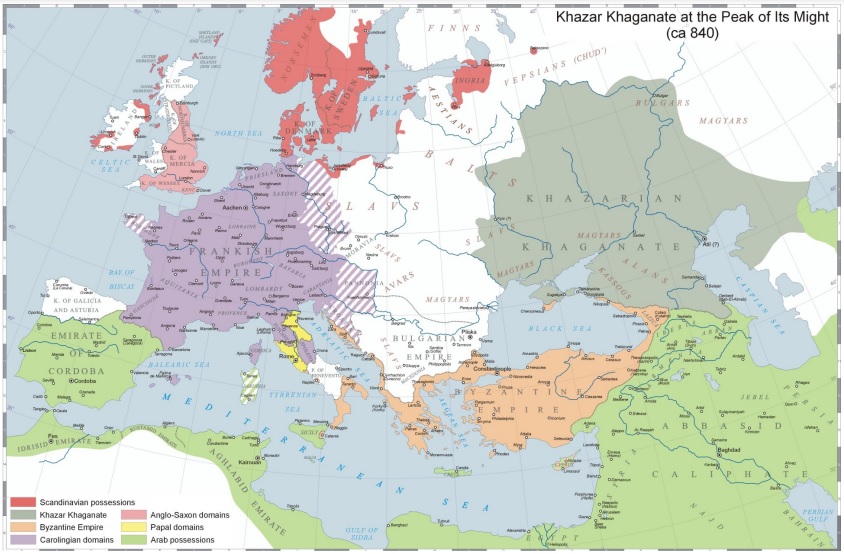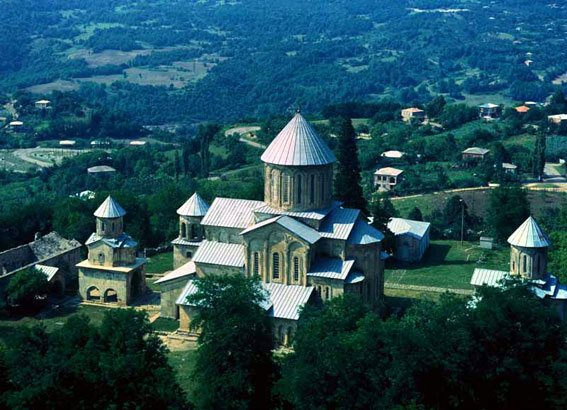KHAZAR KAGHANATE: HISTORY IN A NUTSHELL
By Andrew Andersen
This short text is just a part of an introductory chapter for the new book which will be called ‘The Caucasus Front of the Great War 1914-1918’.
The map was created by Andrew Andersen and George Partskhaladze.

In 576, the Göktürks (‘Blue Turks”) invaded and conquered the entire Ponto-Caspian steppe and the Bosporan province of the East Roman Empire. However, the Göktürk domination did not last long. In 603, their tribal confederation disintegrated, leaving the North Caucasus to fend for itself for a period of time. That was the moment when a new state was born in the area, which later became known as the Khazar Khaganate.
The Khazar state’s roots trace back to the Ugric-Finnish tribe of Savirs, also known as Sabirs and Suvars. In the early 5th century, these tribes migrated from present-day Siberia and settled in the lower Daghestan area of Ciscaucasia, along with the Huns. By the end of the 6th century and the beginning of the 7th century, the Savirs underwent Turkification, influenced by the Göktürks. They also assimilated other nearby tribes and renamed themselves as Khazars. This marked the foundation of the Khazar state.
During the 602-628 Byzantine-Sassanid War, the Khazars joined forces with Byzantium (East Roman Empire) and proved to be a
significant military power.
In the 660s, in conflicts with other Turkic tribes, particularly the Bulgars, the Khazars managed to conquer almost the entire North Caucasus region, as well as a significant portion of the Crimean Peninsula and the lowlands of the Volga and Don Rivers. During this time, their supreme leaders adopted the title of Khagan. The first capital of the Khazar Khaganate was the city of Balanjar, located in the lowlands of the Sulak River.
Meanwhile, the Arab invasion of the North Caucasus began, and the Khazars remained loyal allies of Byzantium in their efforts to repel the Arab forces. Byzantium was also fighting against the Arabs on the Anatolian front at the same time.
In 723, the Arabs captured Derbent and Balanjar. In 730, the Khazars reached the city of Ardabil by passing through the Darial Gorge and Georgia, but they soon withdrew to the north. In 732, a dynastic marriage was arranged between the Byzantine Emperor Constantine V and the daughter of the Khazar Khagan, named Chichak, who was also known as Irina after her baptism.
In 737, Arab forces led by the future caliph Marwan II reached the Don River, but after a devastating war, they withdrew to Derbent in 744 without penetrating further into the North Caucasus beyond this fortress. It was during this Arab invasion that Islam began to spread throughout Ciscaucasia, starting with Daghestan.
In the 740s, Khagan Bulan, the founder of the Bulanid dynasty, converted to Judaism under the influence of the Jewish diaspora and took the name Sabriel. From then on, Judaism became the religion of the elite in the Khazar Khaganate. However, the general population of the state, characterized by religious tolerance, continued to practice Christianity, Islam, and remnants of paganism. The adoption of Judaism by the political and military elite led to a cooling of relations with Byzantium and the end of their military alliance.
In response to the threat of a renewed Arab expansion in the mid-8th century, the Khazar Khaganate moved its capital from Balanjar to the city of Atil, located in the Volga delta. This relocation allowed the Khaganate to better defend itself against potential attacks and facilitated its expansion to the north, which included the annexation of territories encompassing modern-day northern Ukraine and central European Russia.
In the early 9th century, the Khazar Khaganate achieved great power and prominence, emerging as one of the largest and most powerful states in Eastern Europe and the Caucasus. Its strategic location and military strength enabled it to control the vital trade routes connecting Northern and Eastern Europe with the Byzantine Empire and the Islamic world. As a result, the Khaganate played a pivotal role in shaping regional politics and economics.
In the late 9th century, the power of the Khazar Khaganate faced a significant challenge from the Scandinavian Vikings, known in Eastern Europe as the Varangians or Rus. Despite a few decades of uneasy peace and limited political and economic cooperation, the Rus-Khazar wars broke out in 895. By the end of the 960s, the Khaganate suffered a series of defeats, resulting in the loss of its territories and control over the critical trade routes connecting Europe to the Middle East. Ultimately, the Khazar Khaganate collapsed as a political entity by the end of the 10th century, with its people gradually assimilated into neighboring societies.
ეს მოკლე ტექსტი მხოლოდ ნაწილია კანადელი მეცნიერის ენდრიუ ანდერსენის ახალი წიგნის შესავალი თავისა, რომელსაც დაერქმევა „1914-1918 წლების დიდი ომის კავკასიის ფრონტი“.
გაეცანით ენდრიუ ანდერსენის სხვა მნიშვნელოვან ნაშრომებს:
- ენდრიუ ანდერსენი – საქართველო და საერთაშორისო შეთანხმებები 1918 – 1921
- Э. Андерсен – Oтвет Чочиеву из-за океана
- Andersen- Abkhazia and Sochi
- Э. Андерсен – «ТАЮЩАЯ ГРУЗИЯ»
- ენდრიუ ანდერსენი – დნობადი საქართველო
- პასუხი ჩოჩიევს ოკეანის გაღმიდან
- სომხეთ-საქართველოს ომი
- სუდეტური ტრაგედია და საქართველოს ავტონომიების პრობლემა
- ენდრიუ ანდერსენი – აფხაზეთი და სოჭი: კონფლიქტის ფესვები 1918-1921
- ენდრიუ ანდერსენი – ისტორიის ფალსიფიკაცია პოლიტიკური ავანტიურიზმის სამსახურში

















 Soviet-Georgian War and Sovietization of Georgia, II-III. 1921
Soviet-Georgian War and Sovietization of Georgia, II-III. 1921